1.
Phonetics:
Word
Stress. Vowels. Consonants. Proto-Germanic Consonant Shift.
Interpretation of the Proto-Germanic Consonant Shift.
2.
Grammar: Form-building
means. Vowel gradation with special reference to verbs.
Simplification of word structure in Late Proto-Germanic. Role of
stem-suffixes in the formation of declensions. Strong
and
weak
verbs.
3. Vocabulary
Literature:
-
Аракин
И.Д. Очерки по истории английского
языка. –
М, 1955. -
Бруннер
К.
История английского языка. Перев. с
нем. – М.:
Иностранная литература, т. I,
II,
1956. -
Верба
Л.Г. Історія
англійської мови. Посібник для студентів
та викладачів вищих навчальних закладів.
–
Вінниця: НОВА КНИГА, 2006. – 296 с. -
Введение
в германскую
филологию.
Арсеньева М.Г., Балашова
С.П., Берков В.П., Соловьева Л.Н. – М.,
1980. -
Иванова И. П.,
Беляева Т. М. Хрестоматия по истории
английского
языка. Л.,? 1973. -
Иванова
И.П., Чахоян Л.П. История английского
языка. –
М., 1976 -
Ильиш Б.А. История
английского языка. – Л., 1973. -
Расторгуева Т.А.
История английского языка. – М., 2005. -
Смирницкий
А.И. История английского языка. Курс
лекций. –
М., 1965.
All the
Germanic languages of the past and present have common linguistic
features; some of these features are shared by other groups in the IE
family, others are specifically Germanic.
The
Germanic group acquired their specific distinctive features after the
separation of the ancient Germanic tribes from other IE tribes and
prior to their further expansion and disintegration that is during
the period of the PG parent-language. These PG features inherited by
the descendant languages represent the common features of the
Germanic group. Other common features developed later, in the
course of the individual histories of separate Germanic languages, as
a result of similar tendencies arising from PG causes. On the other
hand, many Germanic features have been disguised, transformed and
even lost in later history.
Phonetics Word Stress
The peculiar Germanic system
of word accentuation is one of the most important distinguishing
features of the group; it arose in PG, was fully or partly retained
in separate languages and served as one of the major causes for many
linguistic changes.
It is known
that in ancient IE, prior to the separation of Germanic, there
existed two ways of word accentuation: musical pitch and force
stress. The position of the stress was free and movable, which means
that it could fall on any syllable of the word – a root-morpheme,
an affix or an ending – and could be shifted both in form-building
and word-building (cf. R
дóмом,
домá,
домóвничать,
дóма).
Both these
properties of the word accent were changed in PG. Force or expiratory
stress (also called dynamic and breath stress) became the only type
of stress used. In Early PG word stress was still as movable as in
ancient IE but in Late PG its position in the word was stabilised.
The stress was now fixed on the first syllable, which was usually the
root of the word and sometimes the prefix; the other syllables –
suffixes and endings – were unstressed. The stress could no longer
move either in form-building or word-building.
These features of word accent
were inherited by the Germanic languages, and despite later
alterations are observable today. In Mod E there is a sharp contrast
between accented and unaccented syllables due to the force of the
stress. The main accent commonly falls on the root-morpheme, and is
never shifted in building grammatical forms. The following English
and German words illustrate its fixed position in grammatical forms
and derived words:
English:
be’come,
be’coming, over’come; ‘lover, ‘loving, be’loved;
German:
‘Liebe,
‘lieben ‘ liebte, ge’liebt, ‘lieberhaft, ‘Liebling.
(Cf. these
native words with words of foreign origin which move the stress in
derivation, though never in form-building: ex’hibit
v, exhi’bition
n).
The heavy fixed word stress
inherited from PG has played an important role in the development of
the Germanic languages, and especially in phonetic and morphological
changes. Due to the difference in the force of articulation the
stressed and unstressed syllables underwent widely different
changes: accented syllables were pronounced with great distinctness
and precision, while unaccented became less distinct and were
phonetically weakened. The differences between the sounds in stressed
position were preserved and emphasised, whereas the contrasts
between the unaccented sounds were weakened and lost. Since the
stress was fixed on the root, the weakening and loss of sounds mainly
affected the suffixes and grammatical endings. Many endings merged
with the suffixes, were weakened and dropped. Cf., e.g., the
reconstructed PG word ‘fish’, with its descendants in Old Germanic
languages:
PG *fiskaz,
Gt fisks,
O Icel fiskr,
OE fisc.
(The asterisk * is placed
before reconstructed hypothetical forms which have not been found in
written records; the words may be pronounced exactly as they are
written; spelling in Old Germanic languages was phonetic).
Vowels
Throughout
history, beginning with PG, vowels displayed a strong tendency to
change. They underwent different kinds of alterations: qualitative
and
quantitative,
dependent
and independent.
Qualitative changes affect the quality of the sound, e.g.: [o>a]
or [p>f]; quantitative changes make long sounds short or short
sounds long, e.g.: [i>i:], [ll>l]; dependent
changes (also positional
or combinative)
are restricted to certain positions or phonetic conditions, for
instance, a sound may change under the influence of the neighbouring
sounds or in a certain type of a syllable; independent
changes – also spontaneous
or regular
– take place irrespective of phonetic conditions, i.e. they affect
a certain sound in all positions.
From an
early date the treatment of vowels was determined by the nature of
word stress. In accented syllables the oppositions between vowels
were carefully maintained and new distinctive features were
introduced, so that the number of stressed vowels grew. In unaccented
positions the original contrasts between vowels were weakened or
lost; the distinction of short and long vowels was neutralised so
that by the age of writing the long vowels in unstressed syllables
had been shortened. As for originally short vowels, they tended to be
reduced to a neutral sound, losing their qualitative distinctions and
were often dropped in unstressed final syllables (see the example
*fiskaz).
Strict
differentiation of long and short vowels is commonly regarded as an
important characteristic of the Germanic group. The contrast of short
and long vowels is supported by the different directions of their
changes. While long vowels generally tended to become closer and to
diphthongise, short vowels, on the contrary, often changed into more
open sounds. These tendencies can be seen in the earliest vowel
changes which distinguished the PG vowel system from its PIE source.
IE short [o] changed in Germanic into the more open vowel [a] and
thus ceased to be distinguished from the original IE [a]; in other
words in PG they merged into [o]. The merging of long vowels
proceeded in the opposite direction: IE long [a:] was narrowed to
[o:] and merged with [o:]. The examples in Table 1 illustrate the
resulting correspondences of vowels in parallels from Germanic
and non-Germanic languages (more apparent in Old Germanic languages
than in modern words, for the sounds have been modified in later
history).
Table 1
Соседние файлы в предмете [НЕСОРТИРОВАННОЕ]
- #
- #
- #
- #
- #
- #
- #
- #
- #
- #
- #
Слайд 1
Linguistic features of Germanic languages
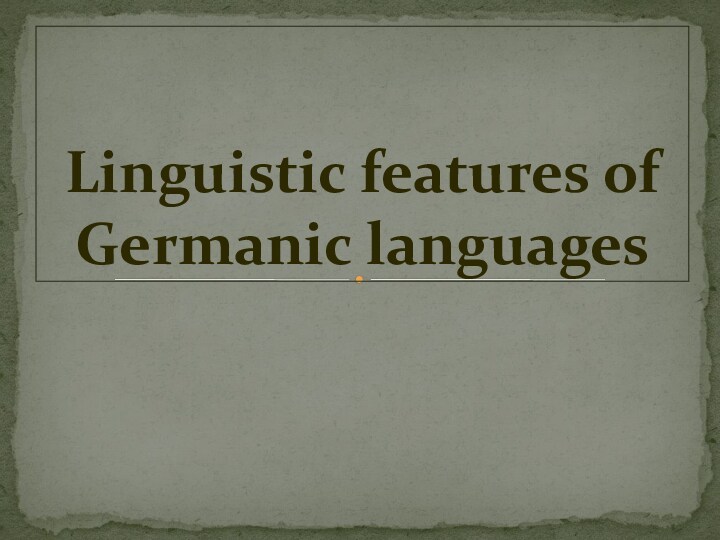
Слайд 2
Phonetics – 1) word stress
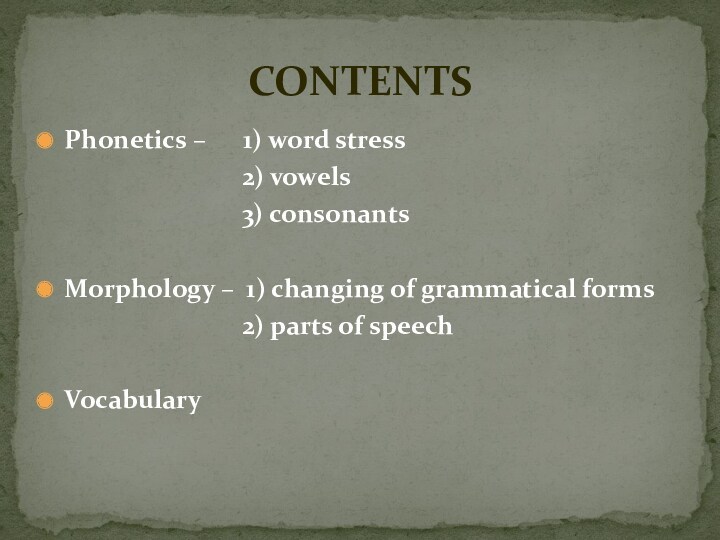
2) vowels
3) consonants
Morphology – 1) changing of grammatical forms
2) parts of speech
Vocabulary
CONTENTS
Слайд 3
Early Proto-Germanic – free and movable
Late Proto-Germanic –
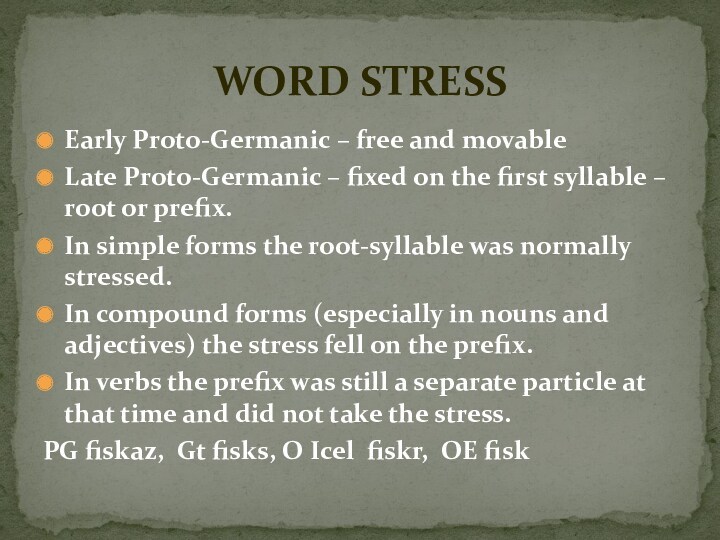
fixed on the first syllable – root or prefix.
In simple forms the root-syllable was normally stressed.
In compound forms
(especially in nouns and adjectives) the stress fell on the prefix.
In verbs the prefix was still a separate particle at that time and did not take the stress.
PG fiskaz, Gt fisks, O Icel fiskr, OE fisk
WORD STRESS
Слайд 4
IE short /ŏ/ and /ǎ/ correspond to GLs
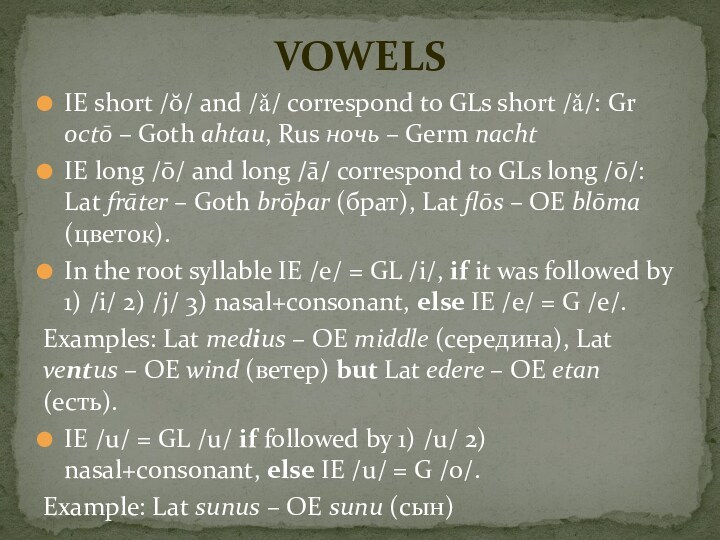
short /ǎ/: Gr octō – Goth ahtau, Rus ночь
– Germ nacht
IE long /ō/ and long /ā/ correspond to
GLs long /ō/: Lat frāter – Goth brōþar (брат), Lat flōs – OE blōma (цветок).
In the root syllable IE /e/ = GL /i/, if it was followed by 1) /i/ 2) /j/ 3) nasal+consonant, else IE /e/ = G /e/.
Examples: Lat medius – OE middle (середина), Lat ventus – OE wind (ветер) but Lat edere – OE etan (есть).
IE /u/ = GL /u/ if followed by 1) /u/ 2) nasal+consonant, else IE /u/ = G /o/.
Example: Lat sunus – OE sunu (сын)
VOWELS
Слайд 5
The 1st Consonant Shift, or Grimm’s Law
IE
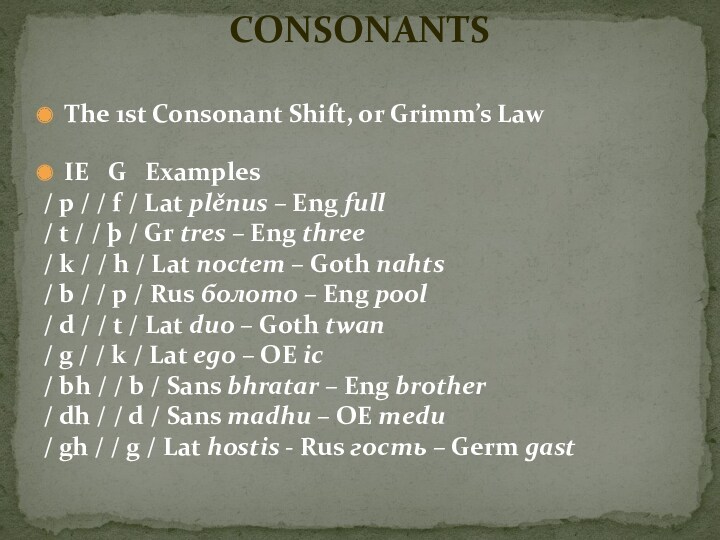
G Examples
/ p / / f / Lat
plěnus – Eng full
/ t / / þ / Gr
tres – Eng three
/ k / / h / Lat noctem – Goth nahts
/ b / / p / Rus болото – Eng pool
/ d / / t / Lat duo – Goth twan
/ g / / k / Lat ego – OE ic
/ bh / / b / Sans bhratar – Eng brother
/ dh / / d / Sans madhu – OE medu
/ gh / / g / Lat hostis — Rus гость – Germ gast
CONSONANTS
Слайд 6
Verner’s Law: unstressed vowel + voiceless stop
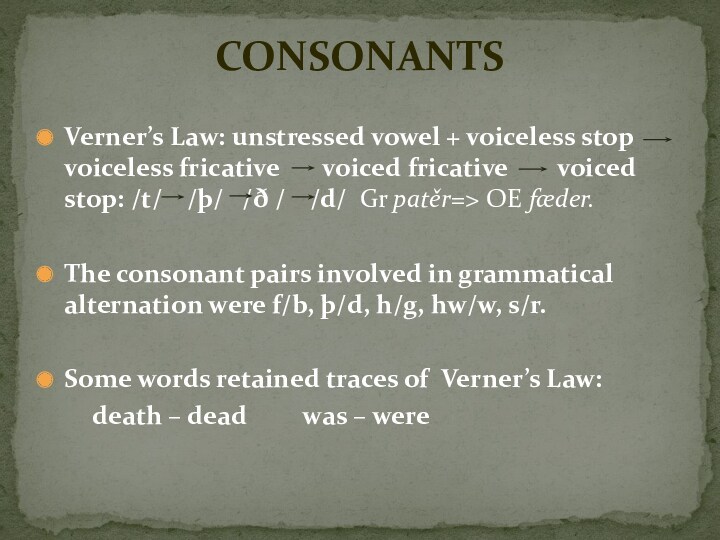
voiceless fricative voiced fricative
voiced stop: /t/ /þ/ /ð /
/d/ Gr patěr=> OE fæder.
The consonant pairs involved in grammatical alternation were f/b, þ/d, h/g, hw/w, s/r.
Some words retained traces of Verner’s Law:
death – dead was – were
CONSONANTS
Слайд 7
Inflections were the principal means of form-building .
Sound
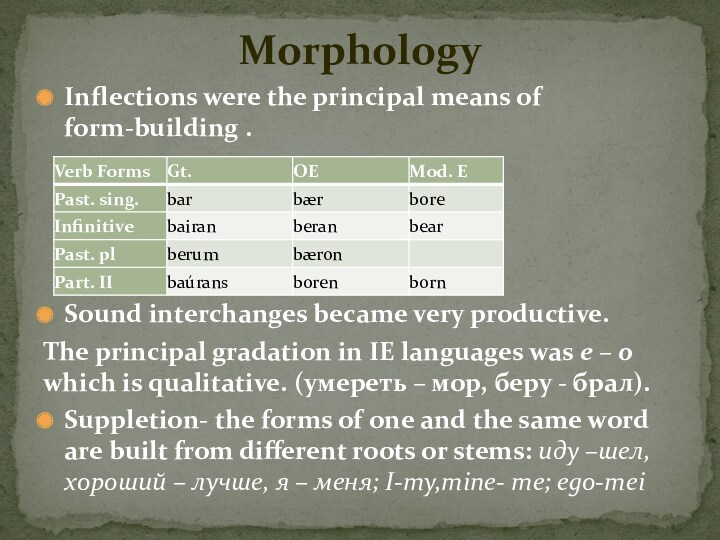
interchanges became very productive.
The principal gradation in IE languages
was e – o which is qualitative. (умереть – мор,
беру — брал).
Suppletion- the forms of one and the same word are built from different roots or stems: иду –шел, хороший – лучше, я – меня; I-my,mine- me; ego-mei
Morphology
Слайд 8
Classes of nouns: 1. vocalic stems a, o,
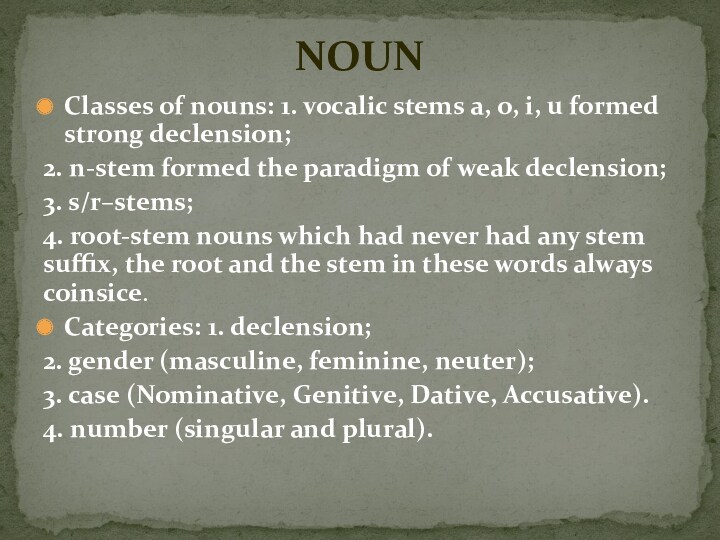
i, u formed strong declension;
2. n-stem formed the paradigm
of weak declension;
3. s/r–stems;
4. root-stem nouns which had never had
any stem suffix, the root and the stem in these words always coinsice.
Categories: 1. declension;
2. gender (masculine, feminine, neuter);
3. case (Nominative, Genitive, Dative, Accusative).
4. number (singular and plural).
NOUN
Слайд 9
Adjective declension in all GLs has no parallel
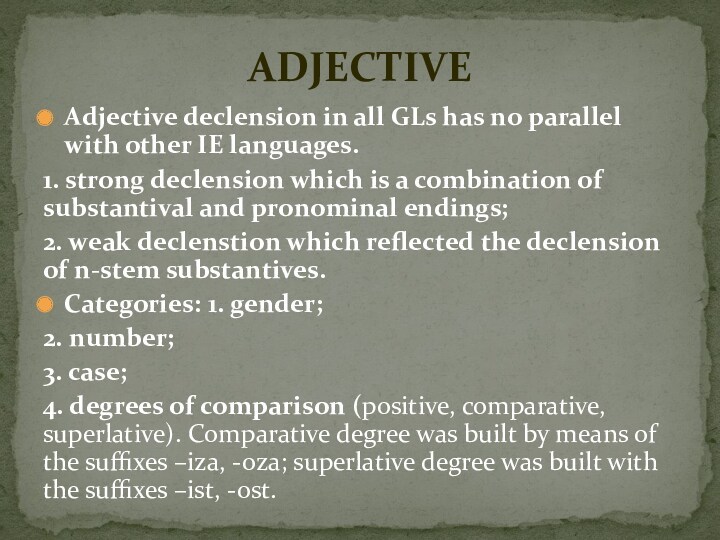
with other IE languages.
1. strong declension which is a
combination of substantival and pronominal endings;
2. weak declenstion which reflected
the declension of n-stem substantives.
Categories: 1. gender;
2. number;
3. case;
4. degrees of comparison (positive, comparative, superlative). Comparative degree was built by means of the suffixes –iza, -oza; superlative degree was built with the suffixes –ist, -ost.
ADJECTIVE
Слайд 10
The oldest classes are personal, demonstrative and interrogative.
Personal
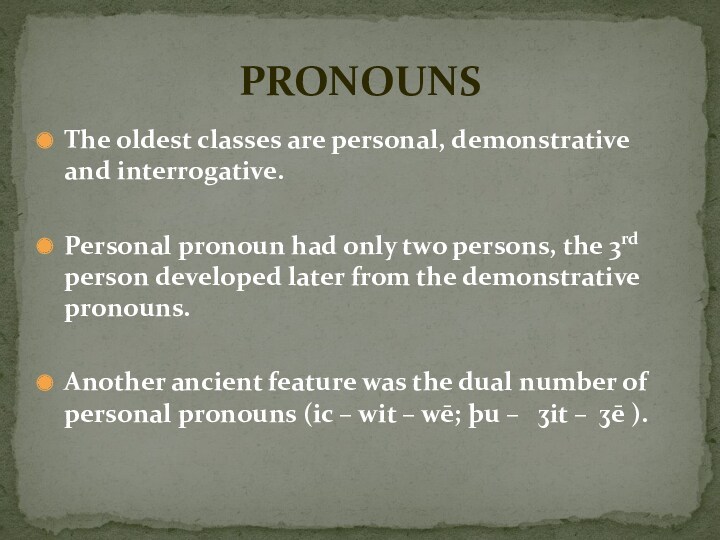
pronoun had only two persons, the 3rd person developed
later from the demonstrative pronouns.
Another ancient feature was the dual
number of personal pronouns (ic – wit – wē; þu – ʒit – ʒē ).
PRONOUNS
Слайд 11
1. Strong verbs (had four principal forms —
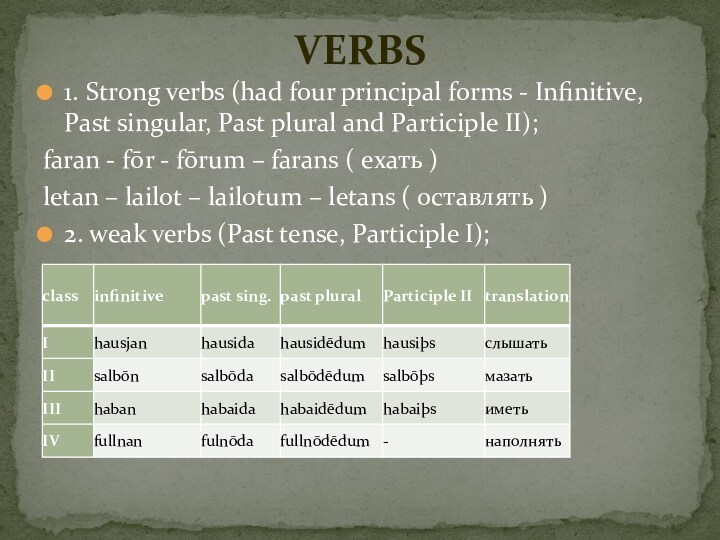
Infinitive, Past singular, Past plural and Participle II);
faran —
fōr — fōrum – farans ( ехать )
letan –
lailot – lailotum – letans ( оставлять )
2. weak verbs (Past tense, Participle I);
VERBS
Слайд 12
3. united preterit-present verbs (used vowel gradation to
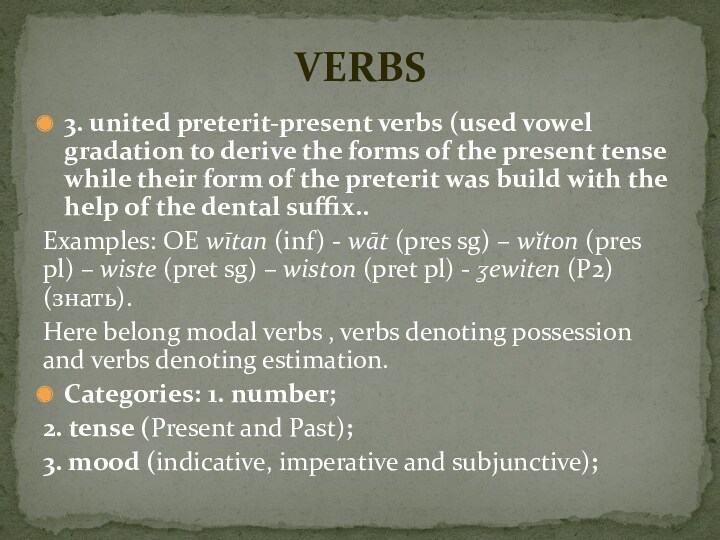
derive the forms of the present tense while their
form of the preterit was build with the help of
the dental suffix..
Examples: OE wītan (inf) — wāt (pres sg) – wĭton (pres pl) – wiste (pret sg) – wiston (pret pl) — ʓewiten (P2) (знать).
Here belong modal verbs , verbs denoting possession and verbs denoting estimation.
Categories: 1. number;
2. tense (Present and Past);
3. mood (indicative, imperative and subjunctive);
VERBS
Слайд 13
IE words
Pure Germanic words
VOCABULARY
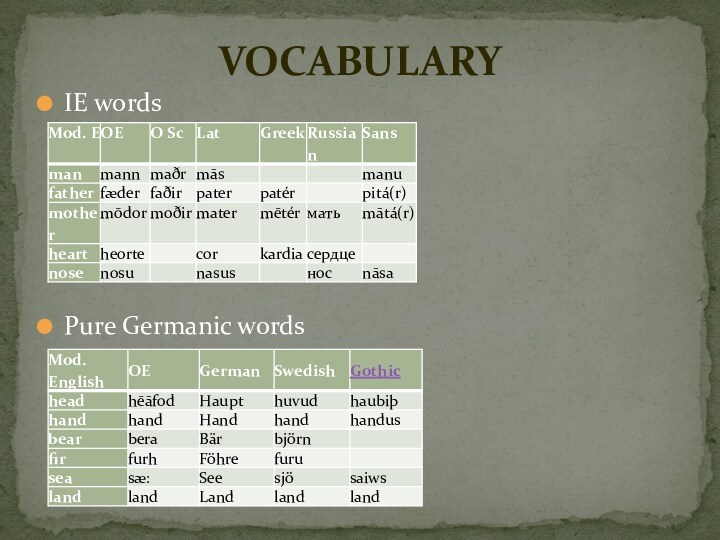
Слайды презентации
Слайд 2
Phonetics – 1) word stress
2) vowels
3) consonants
Morphology – 1) changing of
grammatical forms
2) parts of speech
Vocabulary CONTENTS
Слайд 3
Early Proto-Germanic – free and movable
Late Proto-Germanic – fied on
the frst
syllable – root or prefi.
In simple
forms the root-syllable was
normally stressed.
In compound forms (especially in
nouns
and adjectives) the stress fell on the
prefi.
In verbs the prefi was still a separate
particle at that time and did not take the
stress.
PG fskaz, Gt fsks, O Icel fskr, OE fsk WORD STRESS
Слайд 4
IE short /ŏ/ and /ǎ/ correspond to GLs short /ǎ/:
Gr octō – Goth ahtau , Rus ночь –
Germ nacht
IE long /ō/ and long / ā / correspond
to GLs long
/ō/: Lat frāter – Goth brōþar (брат), Lat flōs –
OE blōma (цветок).
In the root syllable IE /e/ = GL /i/, if it was
followed by 1) /i/ 2) /j/ 3) nasal+consonant,
else IE /e/ = G /e/.
Examples: Lat med i us – OE middle (середина),
Lat ve nt us – OE wind (ветер) but Lat edere –
OE etan (есть).
IE /u/ = GL /u/ if followed by 1) /u/ 2)
nasal+consonant, else IE /u/ = G /o/.
Example: Lat s unus – OE s unu (сын)VOWELS
Слайд 5
The 1st Consonant Shift, or Grimm’s Law
IE G
Eiamples
/ p / / f / Lat plěnus –
Eng full
/ t / / þ / Gr tres –
Eng three
/ k / / h / Lat noctem – Goth nahts
/ b / / p / Rus болото – Eng pool
/ d / / t / Lat duo – Goth twan
/ g / / k / Lat ego – OE ic
/ bh / / b / Sans bhratar – Eng brother
/ dh / / d / Sans madhu – OE medu
/ gh / / g / Lat hostis — Rus гость – Germ gastCONSONANTS
Слайд 6
Verner’s Law: unstressed vowel +
voiceless stop voiceless fricative
voiced fricative voiced
stop: /t/ /þ/
/ð / /d/
Gr patěr => OE fæder.
The consonant pairs involved in
grammatical alternation were f/b, þ/d,
h/g, hw/w, s/r.
Some words retained traces of Verner’s
Law:
death – dead was – were CONSONANTS
Слайд 7
Infections were the principal means of form-
building .
Sound interchanges became
very productive.
The principal gradation in IE languages was e
–
o which is qualitative. (умереть – мор, беру —
брал).
Suppletion- the forms of one and the same
word are built from diferent roots or stems:
иду –шел, хороший – лучше, я – меня; I-my,mine-
me; ego-mei Morphology
Verb
Forms Gt. OE Mod. E
Past. sing. bar bær bore
Infnitive bairan beran bear
Past. pl berum bæron
Part. II baúrans boren born
Слайд 8
Classes of nouns: 1. vocalic stems a, o, i, u
formed strong declension;
2. n-stem formed the paradigm of weak
declension;
3. s/r–stems;
4. root-stem nouns which had never had any
stem
sufi, the root and the stem in these
words always coinsice .
Categories: 1. declension;
2. gender (masculine, feminine, neuter);
3. case (Nominative, Genitive, Dative,
Accusative).
4. number (singular and plural). NOUN
Слайд 9
Adjective declension in all GLs has no
parallel with other
IE languages.
1. strong declension which is a combination
of
substantival and pronominal endings;
2. weak declenstion which refected the
declension
of n-stem substantives.
Categories: 1. gender;
2. number;
3. case;
4. degrees of comparison ( positive,
comparative, superlative). Comparative degree was
built by means of the sufxes –iza, -oza; superlative
degree was built with the sufxes –ist, -ost. ADJECTIVE
Слайд 10
The oldest classes are personal,
demonstrative and interrogative.
Personal pronoun had
only two persons,
the 3 rd
person developed later
from the
demonstrative pronouns.
Another ancient feature was the dual
number
of personal pronouns (ic – wit –
wē; þu – ʒit – ʒē ). PRONOUNS
Слайд 11
1. Strong verbs (had four principal forms —
Infnitive, Past
singular, Past plural and
Participle II);
faran — fōr —
fōrum – farans ( ехать )
letan – lailot –
lailotum – letans ( оставлять )
2. weak verbs (Past tense, Participle I); VERBS
class infnitive past
sing. past plural Participle
II translati
on
I hausjan hausida hausidēdum hausiþs слышать
II salbōn salbōda salbōdēdum salbōþs мазать
III haban habaida habaidēdum habaiþs иметь
IV fullnan fulnōda fullnōdēdum — наполнят
ь
Слайд 12
3. united preterit-present verbs (used
vowel gradation to derive the
forms of the
present tense while their form of
the
preterit was build with the help of the
dental
sufi..
Examples: OE wītan (inf) — wāt (pres sg) – wĭton
(pres pl) – wis te (pret sg) – wis ton (pret pl) —
ʓewiten (P2) (знать).
Here belong modal verbs , verbs denoting
possession and verbs denoting estimation.
Categories: 1. number;
2. tense ( Present and Past) ;
3. mood ( indicative, imperative and subjunctive) ;VERBS
Слайд 13
IE words
Pure Germanic words VOCABULARY
Mod.
E OE O Sc Lat
Gree
k Russi
an Sans
man mann maðr mās manu
fathe
r
fæder faðir pater patér pitá(r)
moth
er mōdo
r moðir mater mēté
r
мать mātá(
r)
heart heort
e cor kardi
a сердц
е
nose nosu nasus нос nāsa
Mod.
English OE German Swedish Gothic
head hēāfod Haupt huvud haubiþ
hand hand Hand hand handus
bear bera Bär björn
fr furh Föhre furu
sea sæ: See sjö saiws
land land Land land land
Слайд 14
Borrowed words VOCABULARY
Mod.
English OE Other Germanic
languages Latin
pound
pund Gt. pund, O. Ic. pund pondō
street stræt,
strēt OHG atrâza OSc
strâta strata
plum, plūme O Icl
plóma prunus
wine win OHG, O Sc win G
wein vinum
shield scyld O Sc skjoldr scutum
write scrifan O Sc scrifa scribere
canon canonic O Sc kanunkr canonicus
Чтобы скачать презентацию — поделитесь ей с друзьями с помощью
социальных кнопок.













